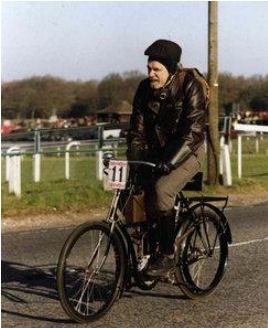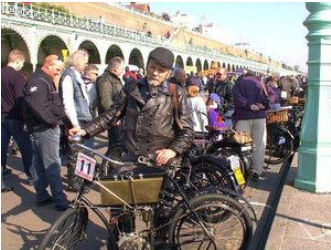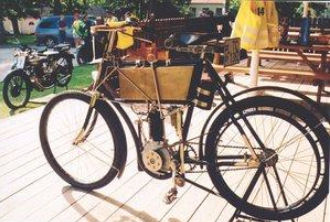It all started back in 1976 when I came across a 1903 Russian Fafnir De Luxe motorbicycle. There was the original frame, the engine and even the rear wheel. Later, research and detective work produced some of the missing items; a petrol/oil tank was replicated; front rim and tyres were bought from Britain; yet I could not find out what those 2 lugs on the frame were for until recently I came across a 1903 photo of a similar German-made machine and it revealed what these two lugs were for: a clutch/belt tensioner device with a toothed rod which could be pulled up to tension the belt or let down to slacken it. A very useful device in traffic if you do not want to start the engine
anew at every traffic light!
The machine had survived through the wars more or less intact although some enterprising guys had tried to use its engine to propel a glider airplane in true pioneering spirit before WW1. Which explains why the original engine pulley was missing and the mainshaft was much longer than standard. I shortened the mainshaft and had a new pulley made up…
Around 1978 I learned from the Vintage Motorcycle Club magazine, and from an original Programme, about the Pioneer Run. This was the beginning of my dreams – if I could only participate in this Run…
My machine was eligible no doubt, but there was the Iron Curtain problem, my bike was a belt–driven small capacity machine which would be impossible to restart at every traffic light, especially near Brighton and last, but not least, I had to first obtain a Pioneer Certificate for the machine in order to qualify as a participant. I had started up the Russia/Fafnir machine on several occasions and even completed an 8 km run with it in 1988 during the Riga Motormuseum Inauguration Rally; but that was all on flat or almost flat ground. Additionally, it had been in warm summer weather with no carburation problems. At the end of year 2002 I decided that I should do something about the 100th birthday of my machine: I would enter it for the Pioneer Run! Then I would organize an International Motorcycle Rally in Kurland, Latvia’s westernmost region, to mark 100 years of the only preserved Russia/Fafnir motorcycle – which had originally been made in Riga, our capital city. The Iron Curtain had disappeared, I had bought a special no-stretch leather/polyamide sandwich transmission belt (from a 200-year-old belt manufacturing company near Stuttgart) and fixed the belt tensioner problem as part of the fine-tuning programme; all that was left was to do some paperwork. I applied for a proper motorcycle registration number and was granted one, thanks to the efforts of the Antique Automobile Club of Latvia. Some eybrows were raised when I turned up for the MoT test with the machine: What?? 100 years old and no lights?? No rear view mirrors?? Flimsy brakes?? Flat belt drive??! Some frantic phone calls were made to the head office of the Department of Vehicle Licencing in Riga and finally the permission was given – the vehicle could pass the test! The next thing was to fill in all the necessary forms and to send them off together with all photographs and other proof plus a cheque for GBP15.00 to the Sunbeam Club Dating Committee. Pioneer Certificate # 1629 was granted to my 1903 Russia/Fafnir 205 c.c. four stroke i.o.e. automatic intake valve machine – we were eligible for the Pioneer Run! Entry forms were downloaded from the Sunbeam Motorcycle Club, duly filled in and sent off with another cheque to the value of GBP41.00. Two weeks before the event I received detailed instructions, vehicle start No 11, route card, car passes, enclosure passes, a programme etc. There was one entrant from the US, a few from Belgium, France and Germany, the majority being from the UK – and also one from Latvia! A big moment. My machine was entered in Class “A”, (machines manufactured from the beginning of the motoring era till the end of 1904). Class “B” included machines made from 1905 till the end of 1909; Class “C” was for machines made from 1910 till the end of 1914. Class “A” and “B” machines were to start in the order of their year of manufacture (my machine was 11th by age out of 320 starters!). Class “C” machines started in the order of handing in their Entries. Thus my start time was 8.05, which meant we had to get up at 5 a.m. to be able to get to Epsom Downs in South London on time – from Enfield in North London, which was my base where I was staying with a VMCC friend and Matchless enthusiast Pat Gill. Starters were allowed to be 30 minutes late at the start line and the distance of Run’s 52 miles had to be made by 15.00 hours to qualify as a finisher.
How did I get to Britain? I loaded the Russia/Fafnir machine in my little FIAT Scudo van and boarded the Riga – Luebeck ferry, then it was a rather easy and fast 305 km run to Esbjerg port in Denmark – from there I took a ferry to Harwich in the UK – all in all a straight and easy route, although not very cheap – cost me nearly Euro 1000,- all included. Here I must make a little diversion to explain some technicalities about my veteran machine. I had stove-enamelled it back in the 1970s, not paying attention to the straightness of the frame. It was duly tested with engine and tank removed and straightened 2 months before the event. When everything was reassembled it was found that the engine pulley and the wheel belt rim were not in line as a consequence of frame straightening! I had to machine 6 mm off the crankcase lug and add a shim on the other side to move the engine in the frame. Now the belt ran straight and it would no longer want to creep off the belt rim. I had tested it with the engine running on a stand – there was too much snow and ice on the roads and the temperature was below freezing point, so I did not try it out on the open road until 2 days before boarding the ferry, when the sun came out and dried the roads and it was warm enough to do a test run. On the last day 2 hours before going to the ferry disaster struck – the tappet follower ball broke through its retaining tube in the tappet housing on the little Fafnir engine! Tappet clearance became 9,5 mm instead of 0,15 mm! The broken part was removed in minutes and welded up and machined in a lathe.
Still in my workshop, a new ball was found, but assembly was left for later – actually it happened on the last evening before the run as it involved engine timing, removal of the cylinder head, grinding in the exhaust valve, filing the valve stem for clearance, etc. Finally the engine ran without a miss – what a relief! Signing on for the run was quick – insurance was checked and at the start a special red sticker was affixed to the machine’s start number – it had to be produced later upon signing off. So the smallest- engined solo machine was off in the Pioneer Run! As it soon turned out it was also the most overgeared one! My engine belt pulley had been made too big in diameter. As I come from a flat country I had never realised that the Pioneer Run route would be so hilly. OK I read about Reigate’s and Pycombe’s dreaded hills; I could use lpa – light pedal assistance – or even push my machine up a couple of hills. But there were dozens of hills…I had not expected that it would be so warm — +20 Centigrade and I had my thermal motorcycle underwear on … Lpa soon turned to hpa – heavy pedal assistance — going uphills and helping the little Fafnir engine until I got a cramp in my right leg! Roadside massage and a little rest and I could continue. Now I could imagine what it might have felt a 100 years ago with no asphalt on the road, road dust flying all over (that dust also containing a large proportion of horse manure) and nails buried in the dust would provide a constant threat of puncture to the flimsy tyres of the period. One had to be constantly on the alert not to scare horses which would be in abundance as a popular means of transport at the time. I did not have to suffer from all this, apart from the fact that the roads in Britain seem to be a bit worse than in Germany or Denmark for example, but instead the roads were congested with cars and modern motorcycles by thousands who had come out of their winter hibernation on a sunny Sunday to spectate and to follow the Pioneer Run. Now this was a really great contrast: machines of yesteryear – some mind-bogglingly strange designs, some of which never made it to series production – and the latest multi-cylinder hi-tech motorcycles of every description rushing past like merciless time… I tried out my belt clutch and was more than happy with it when I could loosen the belt and have the engine running at red lights, the machine stationary in a very civilised manner – to start going again I had to pedal for a few meters to gain momentum, then pull up the roller against the belt and the machine would carry forward. It looked too good actually to believe that it would last the whole distance. I had already done 17 miles under my machine’s and my own power when I heard a strange singing noise – like birdsong coming from below – what could that be? I stopped the machine and instantly diagnosed a seized main bearing bush – on the crankshaft pulley end. I had been economising with oil to avoid oiling the plug – it had worked on previous occasions on short runs, but it turned into a disaster this time. I could still turn the pulley with great effort by hand, but the belt would slip on it and I could not start the engine, thus it would be the end of the run! End of the run? No way! I had to get to the finish line in the saddle! I could have taken the engine out and stripped it to scrape the bush free, but that would have taken half a day. My friend Pat was accompanying me on the run on his 1929 Silver Arrow Matchless – he agreed to tow my machine with me on board the remaining 30 plus miles to Brighton. It felt almost like doing the whole run under the power of my own machine – except that I had to be very careful with the brakes: the front one a stirrup type working against the tyre; the rear a metal cone in hub – both used together could eventually stop you, somehow. Much credit must be given to Pat for his skilful towing technique and gesticulating with oncoming traffic in the roundabouts and crossings – he was a real wizard in stopping and negotiating vehicles which would otherwise make us stop or lose momentum. All I can tell you – people liked it and always waved us through when they saw a veteran motorcycle on tow by a vintage motorcycle (it is legal to tow a motorcycle in the UK – but only with an other motorcycle). The fact that a 1929 Silver Arrow Matchless could tow an other machine with a heavy rider for over 30 miles and some of it uphill without overheating or missing a beat is a very good proof against the popular misconception that the Arrow will not “pull the skin off a rice pudding”! Upon arriving to Madeira Drive, Brighton I had little time left to make photos of the veteran machines as many of the finishers would be in a hurry to take their machines from the paddock to get back to work on Monday as they had come from afar.
Towards the end of the run all the pain had disappeared from my cramped leg. The original British made Hammock seat proved to be too stiff for those 50 plus miles (80 km) of the rather uneven roads en route – should I mention that for the 3 consecutive days I could neither sit down nor climb the stairs without feeling pain in my legs and arms! Yet the unique experience and the satisfaction of getting there on a sunny day may have balanced out the physical pains which were not important – they were a part of the game!
Maybe it was the pioneering spirit which helped in ousting the pain? Or was it higher levels of adrenalin boiling in the veins? This experience can only be appreciated in full by someone who has had a similar feat on a veteran machine – there will not be many such enthusiasts in Latvia for a while. I had a dream; and it materialized in broad daylight. Well – almost… Juris Ramba
Conclusions:
- The main idea why I wanted to participate in the Pioneer Run was to experience the
pioneering spirit and to share it with riders of other unique preserved machines of
bygone era. In this I succeeded. - Driving on the left hand side of the road is not a big problem. Actually after spending a
week in Britain, driving on the left hand side of the road, when you get off the ferry in
Denmark you are so well accustomed to it that for a moment you have to get used to
driving on the right hand side! - I still regard my first Brighton Run as a success – I did what I did fairly well without any
previous experience of longer routes on much steeper gradients than usual. - No great damage has been done to my veteran machine. All I need is to make a
smaller belt pulley, to shorten the belt and to sort out the mainbearing bush on the drive
side and we could give it an other try – maybe next year. - The most difficult part of the Pioneer Run is the last 5 miles when you get into
Brighton: the traffic congestion is appalling!
©copyright Juris Ramba AAK Latvia. Reprinted with kind permission
Posted by JD on the former Multiply website. Retrieved from preserved archival material by Catweazle.


